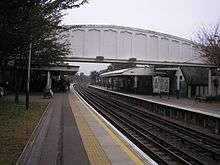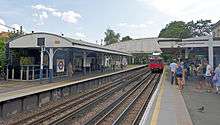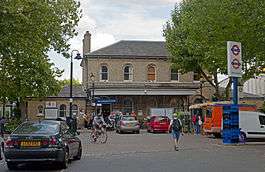Kew Gardens station (London)
| Kew Gardens | |
|---|---|
|
Main entrance on the eastbound side, 2014 | |
 Kew Gardens Location of Kew Gardens in Greater London | |
| Location | Kew |
| Local authority | London Borough of Richmond upon Thames |
| Managed by | London Underground[1] |
| Owner | Network Rail |
| Station code | KWG |
| DfT category | D |
| Number of platforms | 2 |
| Accessible | Yes [2] |
| Fare zone | 3 and 4 |
| London Underground annual entry and exit | |
| 2012 |
|
| 2013 |
|
| 2014 |
|
| 2015 |
|
| National Rail annual entry and exit | |
| 2008–09 |
|
| 2009–10 |
|
| 2010–11 |
|
| 2011–12 |
|
| 2012–13 |
|
| 2013–14 |
|
| Key dates | |
| 1869 | Opened (L&SWR) |
| 1869 | Started (NLR) |
| 1870 | Started and Ended (GWR) |
| 1877 | Started (MR and DR) |
| 1894 | Started (GWR) |
| 1906 | Ended (MR) |
| 1910 | Ended (GWR) |
| 1916 | Ended (L&SWR) |
| Listed status | |
| Listing grade | II |
| Entry number | 1031878[5] |
| Added to list | 26 September 2002 |
| Other information | |
| Lists of stations | |
| External links | |
| WGS84 | 51°28′38″N 0°17′07″W / 51.4771°N 0.2853°WCoordinates: 51°28′38″N 0°17′07″W / 51.4771°N 0.2853°W |
|
| |
Kew Gardens is a Grade II listed[5] London Underground and London Overground station in Kew in the London Borough of Richmond upon Thames. It first opened in 1869 and is now managed by London Underground. The station, which is in Travelcard Zones 3 and 4, is served by both the District line on the London Underground and the North London Line on the London Overground, and is situated midway between Gunnersbury and Richmond stations.
Kew Gardens is the nearest station to the Royal Botanic Gardens, Kew, about 500 yards (460 m) to the west, and The National Archives, about 600 yards (550 m) to the north east.
Kew Gardens Station Footbridge, also a Grade II-listed structure,[6][7] is next to the station, on the southern side.
Access
The main entrance to the station is at the junction of Station Parade, Station Avenue and Station Approach, about 100 yards (90 m) from Sandycombe Road (B353). There is also an entrance, which is wheelchair-accessible, on North Road, on the other side of the railway line; the two entrances are connected by a pedestrian subway.
History
The station was opened by the London and South Western Railway (L&SWR) on 1 January 1869,[8] in an area of market gardens and orchards.[9] The station was located on a new L&SWR branch line to Richmond built from the West London Joint Railway starting north of Addison Road station (now Kensington (Olympia)). The line ran through Shepherd's Bush and Hammersmith via a now closed curve and Grove Road station (also now closed) in Hammersmith. Via a short connection from the North & South Western Junction Railway (N&SWJR) to Gunnersbury the line was also served by the North London Railway (NLR).
Between 1 June 1870 and 31 October 1870, the Great Western Railway (GWR) briefly ran services from Paddington to Richmond via Hammersmith & City Railway (now the Hammersmith & City line) tracks to Grove Road then on the L&SWR tracks through Kew Gardens.[10]
On 1 June 1877, the District Railway (DR, now the District line) opened a short extension from its terminus at Hammersmith to connect to the L&SWR tracks east of Ravenscourt Park station.[8] The DR then began running trains over the L&SWR tracks to Richmond. On 1 October 1877, the Metropolitan Railway (MR, now the Metropolitan line) restarted the GWR's former service to Richmond via Grove Road station.[10]
The DR's service between Richmond, Hammersmith and central London was more direct than the NLR's route via Willesden Junction, the L&SWR's or the MR's routes via Grove Road station or the L&SWR's other route from Richmond via Clapham Junction. From 1 January 1894, the GWR began sharing the MR's Richmond service and served Kew Gardens once again,[10] meaning that passengers from Kew Gardens could travel on the services of five operators.
Following the electrification of the DR's own tracks north of Acton Town in 1903, the DR funded the electrification of the tracks on the Richmond branch, including those through Kew Gardens. This was completed on 1 August 1905[8] and DR services on the line were then operated with electric trains. However, the L&SWR, NLR, GWR and MR services continued to be steam-hauled.
MR services were withdrawn on 31 December 1906 and GWR services were withdrawn on 31 December 1910,[10] leaving operations at Kew Gardens and Gunnersbury to the DR (by then known as the District Railway), the NLR and L&SWR. By 1916, the L&SWR's route through Hammersmith was being out-competed by the District to such a degree that the L&SWR withdrew its service between Richmond and Addison Road on 3 June 1916, leaving the District as the sole operator over that route.[11]
A plaque at the station commemorates its reopening on 7 October 1989 by Michael Portillo MP, Minister of State of Transport, after it had been refurbished.
Present
The two-storey yellow brick station buildings are unusually fine examples of mid-Victorian railway architecture and are protected as part of the Kew Gardens conservation area. The station is one of the few remaining 19th-century stations on the North London Line and had one of the last illuminated banner signals on the London Underground, possibly because of the footbridge. This signal was replaced by an electronic version in 2011.
Kew Gardens is the only station on the London Underground network that has a pub attached to it.[12] The pub has a door (no longer in use) which leads out onto platform 1. Previously known as The Railway, the pub reopened after renovation in 2013 as The Tap on the Line.[12]
Kew Gardens Station Footbridge
| Kew Gardens Station Footbridge | |
|---|---|
 | |
| Carries | Pedestrians |
| Crosses | Railway |
| Locale | Kew, London |
| Heritage status | Grade II listed structure |
| Characteristics | |
| Longest span | 23 metres[6] |
| History | |
| Opened | 1912 |
.jpg)

The footbridge to the south of the station is also noteworthy and is Grade II-listed in its own right.[6][7] The railway line bisected Kew, but it was not until 1912[6] that the bridge was provided to allow residents to cross the tracks safely. It is a rare surviving example of a reinforced concrete structure built using a pioneering technique devised by the French engineer François Hennebique.[13] The bridge has a narrow deck and very high walls, originally designed to protect its users' clothing from the smoke of steam trains passing underneath. It also has protrusions on either side of the deck to deflect smoke away from the bridge structure.[14] It was restored in 2004[15] with a grant from the Heritage Lottery Fund, in a project led by The Kew Society.[14]
Services

Kew Gardens currently has the following London Underground (District line) and London Overground (North London Line) services, which are operated by the S7, D78 Stocks and Class 378s:
District line
North London Line
Connections
London Buses route 391 serves the station, with a bus stop nearby on Sandycombe Road.
There are no lifts. Platform 2 (going towards central London) is at ground level. Platform 1 (going towards Richmond) is reached by a short set of 10 steps; there is also a wheelchair-accessible ramp. The National Archives is on the Platform 1 side of the station. The village proper, Sandycombe Road, and the Royal Botanic Gardens, Kew are on the Platform 2 side, and visitors to those locations who alight at Platform 1 must cross the tracks via either the tunnel underneath (left of the main exit, 15 steps down, then 22 steps up) or the footbridge (right of the main exit, 30 steps up, then 30 steps down). The simplest alternative for those wishing to avoid the steps is to remain on the train while it travels one stop to Richmond and returns.
In popular culture
Kew Gardens station appeared in the BBC comedy-drama Love Soup (Series 2, Episode 1 – Smoke and Shadows, 1 March 2008) as the fictional "Hove West" station.[17]
See also
Notes and references
- ↑ "Safety boost as London Underground to take control of 11 Silverlink stations". Transport for London. 5 December 2006. Retrieved 29 July 2015.
- ↑ "Step free Tube Guide" (PDF). Transport for London. Archived (PDF) from the original on 3 June 2015.
- 1 2 3 4 "Multi-year station entry-and-exit figures" (XLS). London Underground station passenger usage data. Transport for London. April 2016. Retrieved 3 May 2016.
- 1 2 3 4 5 6 "Station usage estimates". Rail statistics. Office of Rail Regulation. Please note: Some methodology may vary year on year.
- 1 2 Historic England. "Kew Gardens station (1031878)". National Heritage List for England. Retrieved 16 September 2016.
- 1 2 3 4 Historic England. "Footbridge at Kew Gardens station (1031879)". National Heritage List for England. Retrieved 16 September 2016.
- 1 2 "Kew Gardens Station Footbridge". Urban Design. Transport for London. Retrieved 1 March 2013.
- 1 2 3 "District Line, Dates". Clive's Underground Line Guides. 27 March 2011. Retrieved 25 July 2011.
- ↑ The rural character of the area around the station is shown on the Ordnance Survey map of 1874.
- 1 2 3 4 "Hammersmith & City Line, Dates". Clive's Underground Line Guides. Retrieved 4 July 2008.
- ↑ "District Line, History". Clive's Underground Line Guides. Retrieved 4 July 2008.
- 1 2 Guy Kelly (21 March 2015). "7 things you never knew about Kew Gardens". The Daily Telegraph. Retrieved 14 August 2015.
- ↑ Hennebique Ferro-Concrete, Theory and Practice, A Handbook for Engineers and Architects (4th ed.). London: L.G. Mouchel & Partners. 1921. p. 381.
- 1 2 Hannah Thorpe (13 September 2003). "Kew footbridge project wins £42,700 lottery grant". Richmond and Twickenham Times. Retrieved 30 November 2015.
- ↑ Plaque, Kew Gardens station footbridge
- ↑ Table 59 National Rail timetable, May 2016
- ↑ Nick Cooper (with Claire Cooper). "Real stations – used as locations". The London Underground in Films & Television. Retrieved 5 September 2015.
External links
| Wikimedia Commons has media related to Kew Gardens (London) station. |
- Transport for London: Kew Gardens Underground station
- London Transport Museum Photographic Archive
- Train times from National Rail
| Preceding station | Following station | |||
|---|---|---|---|---|
Terminus | District line | towards Upminster |
||
| Preceding station | Following station | |||
Terminus | North London Line | towards Stratford |
||
| Former services | ||||
| Richmond Terminus |
London and South Western Railway (1869-1916) |
Gunnersbury towards West Brompton | ||
| Metropolitan Railway (1877-1906) |
Gunnersbury towards Paddington | |||
| Great Western Railway (1894-1910) |
||||
| Abandoned plans | ||||
| Preceding station | Following station | |||
Terminus | Central line (1913 & 1920) | towards Liverpool Street |
||

